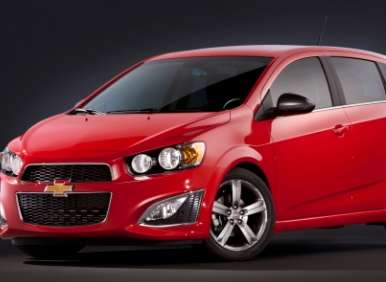Recent Articles
Popular Makes
Body Types
2013 Chevy Sonic RS: A Hot Hatch for the 21st Century
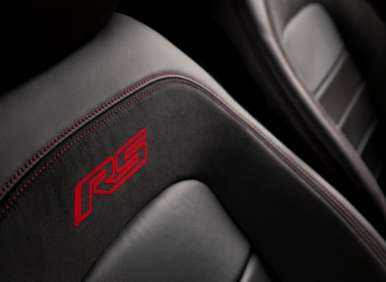
Continuing to show off GM’s new-found ability to work smarter, Chevrolet has unwrapped the 2013 Chevy Sonic RS just in time for the holiday season. And this is no appearance-only upgrade, although the car does get some nice aero pieces and accents; Chevrolet engineers have put their hands on much of the Sonic’s running gear to create a car that should be both truly fun to drive and fairly fuel-efficient at the same time.
Standard Turbo Power
The Sonic RS is scheduled to make its public premiere in January at the North American International Auto Show (aka, the Detroit Auto Show), and it will launch later next year in a relatively open space in the market. At this stage, no other “next-gen” subcompact from the usual suspects is available in a unique performance iteration. It’s true that the Blue Oval beat Chevy to the punch to some extent by showcasing a hi-po Ford Fiesta ST concept at the L.A. Auto Show in November, but that latter car, when it does come to production, is likely to be more of a full-out performance choice along the lines of the VW GTI. The tip-off here is the Fiesta ST concept’s powertrain, in which Ford has EcoBoosted the current model’s 1.6-liter I4 from 120 hp up to about 180. The result, however, will certainly have an equally boosted MSRP that will eliminate it from the shopping lists of many the segment’s typical buyers.
The Sonic RS won’t offer a new engine, but that’s because the current lineup already offers a forced-induction powerplant—currently the only one in the segment. This is what I mean by working smarter, too. Chevy has made the decision to chase fuel-efficiency in the Sonic—and the Chevy Cruze—by going the forced-induction route. It’s much the same strategy as used by Ford—turbocharging puts the “boost” in the company’s EcoBoost engines—but the tactics are different. Ford first started using its tech in bigger vehicles like the Ford F-150, Ford Explorer, Ford Taurus, etc., and even then, the company began by using EcoBoost V6s as replacements for V8 engines.
Thus, the current Sonic, when outfitted with GM’s 1.4-liter turbo Ecotec engine, bring 138 horses to the party—the high-mileage Fiesta SFE makes do with a somewhat meager 120 hp. The kicker, of course, being that the Sonic and Fiesta ring up identical EPA lines of 29 mpg city/40 mpg highway/33 mpg combined. And while the 40-mpg Sonic only is available with a six-speed manual transmission, and the 40-mpg Fiesta only with an automatic, that’s actually an advantage for the Chevy in terms of the driving experience.
EPA estimates weren’t realized for the Sonic RS, but I’m betting we see around 35 mpg highway, perhaps higher.
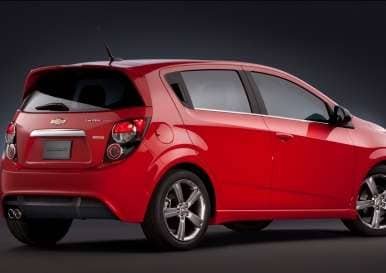
Handling the Need for Speed
Satisfied with that turbocharged I4, Chevy put most of its performance-boosting efforts into the car’s handling. The suspension was both lowered and stiffened, and receives a set of model-specific performance-tuned dampers, too. Up front, the Sonic remains well-supported by MacPherson struts with coil springs and a stabilizer bar; the rear gets a semi-independent compound link-type setup with a “robust” torsion beam and gas-charged shocks. In addition, Chevy points out that, because the front and rear tracks—essentially the side-to-side distance between the tires—measure exactly the same, the Sonic RS benefits from improved stability and balance. (In a number of front-wheel-drive vehicles, like the Hyundai Accent as a random example, the front track is a bit wider than the rear; as an FYI, that’s not the case in the Fiesta, though.)
The Sonic RS also will benefit from more effective stoppers, courtesy of disc brakes at all four corners—all other Sonic models rely on rear drums—along with a four-channel anti-lock braking system and brake-force distribution to optimize stopping performances based on differing driving scenarios.
Significantly, there was one key powertrain advance for the Sonic RS: new gear ratios engineered for a more athletic approach to motoring. All six cogs are changed up in the six-speed DIY gearbox, while the automatic gets a revised final drive ratio.
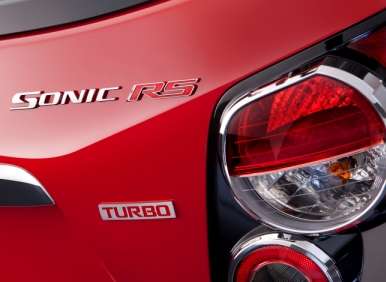
Aero Pieces Hit the Bull’s-eye
As should be clear by now, the Sonic RS represents more than just Chevy slapping a new body kit on the Sonic hatchback, but the brand did that, too. The car wears an RS-only grille, front and rear fascias, rear spoiler, and rocker panels, and a particular focal point is the new look for the car’s fog lamps. The design and placement of a vehicle’s fog lamps can have a major impact on its appearance—sort of like dimples on a person’s face—but they don’t often get the attention they deserve. That’s not the case at Chevy, where finely detailed fog-lamp housings seem to have become de rigueur across the lineup. Here, the lamps themselves have a sophisticated, elongated diamond shape and are housed right in the same space used for the front inlets.
Other style points on the Sonic RS:
• Model-specific 17-inch five-spoke wheels
• A chrome-tipped, sport-tuned exhaust system
• Contrast-colored side-mirror caps
• Front sport seats
• A racing-style flat-bottomed steering wheel with a beefier rim
• Aluminum sport pedals
• Various special instrument-panel graphics, RS badging and interior trim touches
Nor does the Sonic RS skimp when it comes to technology, either. The brand’s Chevrolet MyLink infotainment/connectivity system is standard, and, in another canny move by Chevy, much is being made of its ability to function as a low-cost nav unit, something not seen very often among the subcompacts—or anywhere else, for that matter. The “secret”? MyLink allows owners to download driving directions from one of the increasingly popular smartphone nav apps, then display them on its seven-inch color touch screen. Unsurprisingly, Pandora and Stitcher Internet radio interfaces also are standard.
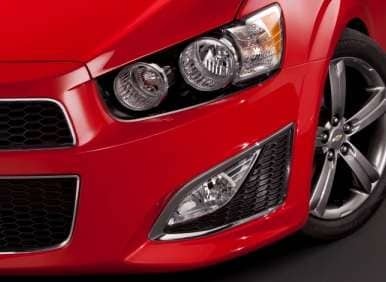
Anything but the Chevy Aveo 2.0
The biggest disservice that Chevy does to the Sonic RS—and the Sonic family in general—is relying on what appears to be the same sheet metal used on the Aveo, only slightly massaged for the new model year. I still see the same stance in the Sonic hatch, and same basic proportions, especially from the rear three-quarters view, and that’s not disguised much by the RS—which, as those with long-ish memories will recall, got its start as the 2010 Chevy Aveo RS concept. But if the reason for the soft-touch approach to the Sonic’s exterior was the fact Chevy decided to put more of its resources into the car’s much-improved hardware, I suppose that’s a small price to pay for the successful result.
